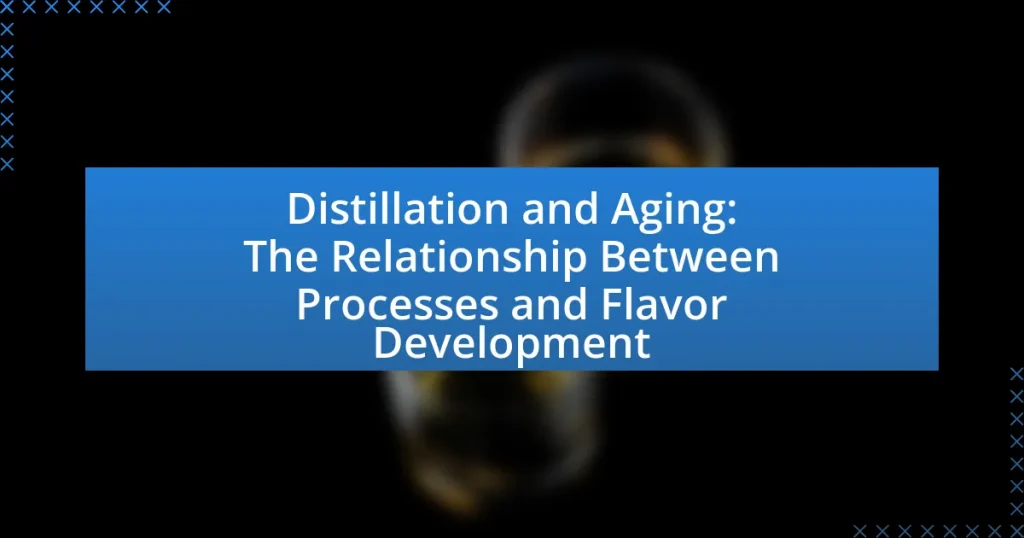The article examines the relationship between distillation and aging in the flavor development of spirits. It details how distillation separates alcohol from fermented mash, concentrating flavors and removing impurities, while aging in wooden barrels enhances complexity through interaction with wood compounds. Key stages of distillation, the impact of different methods on flavor profiles, and the chemical changes that occur during aging are discussed. Additionally, the article highlights historical perspectives, best practices for producers, and the sensory impacts of these processes on the final product, emphasizing their critical roles in defining the quality and character of various spirits.

What is the relationship between distillation and aging in flavor development?
Distillation and aging are interconnected processes that significantly influence flavor development in spirits. Distillation separates alcohol from the fermented mash, concentrating flavors and removing impurities, which lays the foundation for the spirit’s character. Aging, typically in wooden barrels, allows the spirit to interact with the wood, extracting compounds such as vanillin and tannins, which enhance complexity and depth of flavor. Research indicates that the aging process can alter the chemical composition of the spirit, leading to the development of new flavors and aromas, as evidenced by studies showing that aged spirits often exhibit smoother profiles and richer taste characteristics compared to their unaged counterparts.
How does distillation influence the flavor profile of spirits?
Distillation significantly influences the flavor profile of spirits by separating volatile compounds based on their boiling points, which allows for the concentration of desired flavors while removing unwanted impurities. During the distillation process, the initial liquid is heated, causing the alcohol and other volatile components to evaporate. These vapors are then collected and condensed back into liquid form, resulting in a spirit that retains specific flavor compounds, such as esters and phenols, which contribute to its unique taste. For example, in whiskey production, the distillation process can enhance fruity or floral notes while reducing harshness, leading to a smoother final product. This selective separation is crucial in defining the character of various spirits, as evidenced by the distinct flavor profiles of gin, vodka, and rum, each shaped by their respective distillation methods and the raw materials used.
What are the key stages of the distillation process?
The key stages of the distillation process are heating, vaporization, condensation, and collection. During heating, the liquid mixture is heated to its boiling point, causing the more volatile components to vaporize. In the vaporization stage, the vapor rises through a column or still, separating components based on their boiling points. Condensation occurs when the vapor cools and transforms back into liquid form, typically in a condenser. Finally, in the collection stage, the condensed liquid, known as distillate, is collected for further processing or aging. These stages are critical for separating and purifying liquids, as evidenced by their application in producing spirits, where specific flavor profiles are developed through careful control of these stages.
How do different distillation methods affect flavor compounds?
Different distillation methods significantly influence the composition and intensity of flavor compounds in spirits. For instance, pot still distillation typically retains more of the original flavor profile due to its batch process and lower distillation efficiency, allowing for a richer and more complex flavor. In contrast, column still distillation, which operates continuously and is more efficient, often results in a purer spirit with fewer flavor compounds, leading to a cleaner taste. Research indicates that pot stills can produce spirits with higher levels of esters and phenols, which contribute to fruity and floral notes, while column stills tend to emphasize alcohol purity over flavor complexity. This distinction is crucial in the production of various spirits, such as whiskey and rum, where the choice of distillation method directly impacts the final flavor profile.
What role does aging play in flavor enhancement?
Aging plays a crucial role in flavor enhancement by allowing chemical reactions to occur that develop and deepen the flavor profile of beverages, particularly in spirits and wines. During aging, compounds such as phenols and esters interact with oxygen and other elements in the environment, leading to the formation of complex flavors and aromas. For example, whiskey aged in charred oak barrels absorbs compounds from the wood, such as vanillin and tannins, which contribute to its rich flavor. Studies have shown that aging can significantly increase the complexity and richness of flavors, with some spirits improving in quality over years of maturation.
How does the aging process alter the chemical composition of spirits?
The aging process alters the chemical composition of spirits primarily through the interaction between the spirit and the wood of the aging vessel, typically oak barrels. During aging, compounds such as tannins, lignin, and vanillin from the wood are extracted into the spirit, contributing to flavor and aroma development. Additionally, the oxidation process occurs as oxygen permeates through the barrel, leading to the formation of new compounds like esters and aldehydes, which enhance complexity and smoothness. Research indicates that these chemical changes can significantly influence the sensory characteristics of the spirit, with studies showing that aged spirits often exhibit a richer flavor profile and improved mouthfeel compared to their unaged counterparts.
What factors during aging contribute to flavor complexity?
During aging, several factors contribute to flavor complexity, including chemical reactions, wood interaction, and environmental conditions. Chemical reactions such as oxidation and esterification occur as compounds in the spirit interact over time, leading to the development of new flavors. The interaction with wood, particularly in barrels, introduces compounds like vanillin and tannins, which enhance flavor profiles. Additionally, environmental conditions such as temperature and humidity influence the rate of aging and the extraction of flavors from the wood. These factors collectively create a more nuanced and complex flavor profile in aged spirits.

Why are distillation and aging critical in the production of spirits?
Distillation and aging are critical in the production of spirits because they significantly influence the flavor, aroma, and overall quality of the final product. Distillation separates alcohol from the fermented mash, concentrating desirable flavors while removing impurities, which results in a higher alcohol content and a cleaner taste. For example, the distillation process for whiskey typically involves multiple distillations to achieve a refined spirit. Aging, on the other hand, allows the spirit to interact with the wood of the barrels, which imparts complex flavors such as vanilla, caramel, and spice, while also mellowing harsh alcohol notes. Research indicates that aging in oak barrels can enhance the flavor profile by introducing compounds like lignin and tannins, which contribute to the spirit’s character. Thus, both distillation and aging are essential for developing the unique qualities that define various spirits.
What are the historical perspectives on distillation and aging?
Distillation and aging have evolved significantly throughout history, with origins tracing back to ancient civilizations. The earliest documented distillation processes occurred in Mesopotamia around 2000 BCE, where distillation was primarily used for producing perfumes and medicinal substances. By the 8th century, distillation techniques spread to Europe through the Islamic Golden Age, where scholars like Al-Razi refined the process for producing alcohol.
Aging, particularly in the context of spirits, began to gain recognition in the 17th century when barrels made from oak were used to store distilled beverages. This practice not only improved the flavor profile through interaction with the wood but also contributed to the development of color and aroma. The significance of aging was further emphasized in the 19th century with the establishment of regulations for aging processes, particularly in regions like Scotland and Kentucky, where specific aging periods became synonymous with quality.
The historical perspectives on distillation and aging highlight a progression from rudimentary techniques to sophisticated methods that enhance flavor development, underscoring the importance of both processes in the production of spirits.
How have distillation techniques evolved over time?
Distillation techniques have evolved significantly from ancient methods to modern practices. Initially, distillation was performed using simple pot stills, which date back to around 3000 BC in Mesopotamia, primarily for the production of perfumes and medicinal substances. Over time, the introduction of the alembic still in the Middle Ages allowed for more efficient separation of alcohol from water, enhancing purity and yield.
The 19th century saw the development of column stills, which enabled continuous distillation and increased production capacity, revolutionizing the spirits industry. This advancement allowed for the creation of higher-proof spirits and greater consistency in flavor profiles.
In recent decades, advancements in technology, such as vacuum distillation and fractional distillation, have further refined the process, allowing for precise control over temperature and pressure, which enhances flavor extraction and retention. These modern techniques enable distillers to create unique flavor profiles by manipulating the distillation process, thus directly influencing the aging and flavor development of spirits.
What traditional aging methods are still in use today?
Traditional aging methods still in use today include barrel aging, specifically in oak barrels, and solera systems. Barrel aging allows spirits and wines to develop complex flavors through interaction with the wood, which imparts tannins and vanillin, enhancing the overall profile. The solera system, used primarily in sherry production, involves fractional blending of different vintages, ensuring consistency and depth of flavor over time. These methods have historical significance, with barrel aging dating back centuries and solera systems originating in the 18th century, demonstrating their enduring relevance in flavor development.
What are the sensory impacts of distillation and aging on spirits?
The sensory impacts of distillation and aging on spirits significantly influence their flavor, aroma, and mouthfeel. Distillation concentrates the alcohol and volatile compounds, enhancing the spirit’s purity and intensity, while also removing undesirable elements. For example, the distillation process can elevate fruity or floral notes, depending on the raw materials used, such as grains or fruits.
Aging, on the other hand, introduces complex flavors through interaction with the wood of barrels, where compounds like vanillin and tannins are extracted, contributing to notes of vanilla, caramel, and spice. Research indicates that aging can also soften the spirit’s mouthfeel, making it smoother and more rounded. The interaction with oxygen during aging further develops the spirit’s character, leading to a more nuanced sensory profile.
In summary, distillation enhances the concentration of desirable flavors, while aging adds depth and complexity, resulting in a well-rounded sensory experience.
How do consumers perceive flavors developed through distillation?
Consumers perceive flavors developed through distillation as complex and nuanced, often associating them with higher quality and craftsmanship. Research indicates that distillation enhances the concentration of desirable flavor compounds while removing undesirable elements, leading to a more refined taste profile. For instance, a study published in the Journal of Agricultural and Food Chemistry found that distillation can significantly alter the aromatic compounds in spirits, which directly influences consumer preferences and perceptions of flavor richness.
What are the common flavor notes associated with aged spirits?
Common flavor notes associated with aged spirits include vanilla, caramel, oak, spice, and dried fruit. These flavors develop during the aging process as the spirit interacts with the wood of the barrels, which imparts compounds such as vanillin and tannins. Research indicates that the interaction between the spirit and the barrel wood significantly influences the flavor profile, with studies showing that aging in charred barrels enhances notes of caramel and spice due to the breakdown of lignin and hemicellulose in the wood.

How can producers optimize distillation and aging for desired flavors?
Producers can optimize distillation and aging for desired flavors by carefully controlling temperature, time, and the choice of barrels during these processes. In distillation, maintaining specific temperature ranges allows for the selective separation of volatile compounds, which directly influence flavor profiles. For example, higher temperatures can extract more robust flavors, while lower temperatures may yield lighter, more delicate notes.
During aging, the type of barrel used—such as new oak versus used barrels—affects the infusion of flavors like vanilla, caramel, and spice from the wood. The duration of aging also plays a critical role; longer aging periods can enhance complexity but may also lead to over-oaking if not monitored. Research indicates that the interaction between spirit and wood during aging can significantly alter flavor compounds, with studies showing that certain wood treatments can enhance desirable flavor characteristics.
By strategically managing these variables, producers can achieve a targeted flavor profile that aligns with consumer preferences and market trends.
What best practices should be followed in the distillation process?
Best practices in the distillation process include maintaining optimal temperature control, ensuring proper equipment cleanliness, and selecting suitable raw materials. Optimal temperature control is crucial as it affects the separation of volatile compounds; for instance, maintaining a steady temperature allows for the efficient separation of desired flavors while minimizing unwanted impurities. Clean equipment prevents contamination, which can alter the flavor profile and quality of the final product. Additionally, using high-quality raw materials ensures that the initial flavors are preserved and enhanced during distillation, leading to a superior end product. These practices are supported by industry standards that emphasize the importance of precision and quality in distillation to achieve desired flavor outcomes.
How can temperature and pressure control enhance flavor extraction?
Temperature and pressure control enhances flavor extraction by optimizing the solubility and volatility of flavor compounds during distillation. Higher temperatures increase the kinetic energy of molecules, allowing for more efficient extraction of volatile compounds, while controlled pressure can lower the boiling point of liquids, facilitating the extraction process at lower temperatures. Research indicates that specific temperature and pressure settings can significantly influence the profile of extracted flavors, as demonstrated in studies where varying these parameters resulted in distinct flavor profiles in distilled spirits. For instance, a study published in the Journal of Agricultural and Food Chemistry found that adjusting pressure during distillation led to a more pronounced extraction of desirable aromatic compounds, confirming the critical role of these variables in flavor development.
What role does the choice of raw materials play in distillation outcomes?
The choice of raw materials significantly influences distillation outcomes by affecting the flavor profile, purity, and overall quality of the distilled product. Different raw materials, such as grains, fruits, or botanicals, contain varying chemical compounds that contribute to the final taste and aroma. For instance, the presence of specific sugars, acids, and phenolic compounds in fruits can lead to distinct flavor characteristics in spirits like brandy. Additionally, the fermentation process, which is influenced by the type of raw materials used, can produce different alcohols and esters, further impacting the distillation results. Studies have shown that the choice of raw materials can alter the boiling points of components, affecting separation efficiency during distillation, which ultimately determines the quality and complexity of the final product.
What strategies can be employed during aging to achieve specific flavor profiles?
To achieve specific flavor profiles during aging, strategies such as controlling temperature, humidity, and the type of barrels used are essential. Temperature influences the rate of chemical reactions, with warmer conditions accelerating the extraction of compounds from the wood, while humidity affects the evaporation of volatile compounds, impacting flavor concentration. The choice of barrels, including their toasting and charring levels, directly contributes to the flavor profile by imparting various compounds like vanillin and tannins. Research indicates that different wood types, such as American oak versus European oak, yield distinct flavor characteristics, further emphasizing the importance of barrel selection in flavor development.
How does barrel selection impact the aging process?
Barrel selection significantly impacts the aging process by influencing the flavor, aroma, and overall character of the distilled spirit. Different types of wood, such as American oak or European oak, impart distinct compounds during aging; for instance, American oak tends to contribute vanilla and caramel notes due to its higher lactone content, while European oak often adds spicier and more tannic characteristics. The toasting and charring levels of the barrels also affect the extraction of these compounds, with heavier charring leading to more intense flavors and color extraction. Research indicates that the interaction between the spirit and the wood can alter the chemical composition of the liquid, enhancing complexity and depth over time.
What are the effects of different aging environments on flavor development?
Different aging environments significantly influence flavor development in distilled spirits. Factors such as temperature, humidity, and the type of storage vessel interact to create distinct flavor profiles. For instance, higher temperatures accelerate chemical reactions, leading to faster extraction of compounds from the wood, which can enhance vanilla and caramel notes. Conversely, cooler environments slow down these processes, resulting in more subtle flavor development. Humidity levels also play a crucial role; higher humidity can lead to a greater loss of water from the barrel, concentrating flavors, while lower humidity may result in more evaporation of volatile compounds, altering the final taste. Research indicates that these environmental factors can lead to variations in flavor intensity and complexity, as evidenced by studies showing that spirits aged in different climates exhibit unique sensory characteristics.
What practical tips can producers implement for effective distillation and aging?
Producers can implement several practical tips for effective distillation and aging, including controlling temperature and pressure during distillation, selecting appropriate aging barrels, and monitoring environmental conditions. Maintaining a consistent temperature during distillation ensures optimal separation of volatile compounds, which directly influences flavor profiles. For aging, using barrels made from specific types of wood, such as American oak, can enhance flavor due to the wood’s natural compounds, which interact with the spirit. Additionally, monitoring humidity and temperature in aging warehouses is crucial, as these factors affect evaporation rates and the interaction between the spirit and the barrel. Studies have shown that these practices significantly impact the final product’s quality and flavor complexity.


